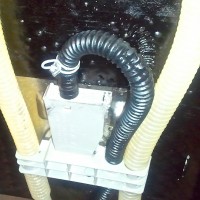 Kathy spotted a leak under the dishwasher. (KitchenAid KUDL02FRSS0.) I shut off the fuse, disconnected the power (because the electrical cable is too short to pull the washer all the way out) and removed the white sound blanket. There was water under the washer, but I could not see the source. There was a silver metal jacket inlet hose from the sink and a yellowish plastic drain hose, but neither were wet. The tub itself did not seem to have any leaks. It was a mystery.
Kathy spotted a leak under the dishwasher. (KitchenAid KUDL02FRSS0.) I shut off the fuse, disconnected the power (because the electrical cable is too short to pull the washer all the way out) and removed the white sound blanket. There was water under the washer, but I could not see the source. There was a silver metal jacket inlet hose from the sink and a yellowish plastic drain hose, but neither were wet. The tub itself did not seem to have any leaks. It was a mystery.
I decided I would run a cycle with the dishwasher out on the floor to see if I could spot the source of the leak. This meant wiring in an extension on the short power cable. The cat watched intently as I worked under the washer with “the stringy things.” The cat likes to play with stringy things. Kathy suggested I set it on rinse to get the quickest look. As I turned it on, we both spotted the leak immediately. A small black hose on the side sprayed two small streams of water up in the air! I cancelled the cycle.
This black plastic inlet hose is what fills up the washer from the on/off valve connected to the metal jacket inlet hose. While the metal jacket hose is always under pressure, the black hose has little pressure and normally has none, transporting hot water from the valve into the tub from the left side of the washer. At the top bend in the hose was a damaged spot that has some small cuts in it. The black rubber mat that surrounds the tub (vibration / sound?) had groove impressions in it from that same spot. (See close up.) It was as if something had gotten wedged in on the side and pinched the hose, creating a weakness.
However there is nothing that could do that as installed. The interior wall is smooth and flat. In fact, the white drain hose that runs in a parallel vertical loop with the black hose (see photo) is much wider and would get pinched first. I think this damage must have happened prior to or during install and like an aneurism in a blood vessel, the weak spot finally gave way.

Received the black hose from eBay and installed it. Exact fit. Dishwasher is now good as almost new. The temporary vinyl tube patch seemed to be doing just fine. It is like heavy aquarium hose, so not sure why not go with that and just check it once a year.
Hi Jeb, Your article describes exactly what is going on with our Kitchenaid dishwasher! I removed the dishwasher because we are having the kitchen floor replaced. On removal, I felt that the “big white diaper” on the left side was damp and also then noticed blistering of the engineered wood of the cabinet where the white insulation comes into contact with the side of the cabinet. The black inlet tube seems to be oily. It has a shiny look in some placed along its length as if it has oil residue on it. It also feels a tiny bit sticky, also supporting the oil idea. Not sure why that would be. The spring clips at each end seemed loose to me. I could quite easily spin them with my fingers. I have now re-installed the dishwasher (the flooring guy postponed by a month!), without fixing the leak. It must be a tiny leak – it has been in service for 6 years with no evidence except when I discovered it on removal. Also, at the time, I knew I would be removing it again in a month. At that stage, I will see about finding the leak and getting a new inlet tube if necessary.
Thanks for writing this article – It certainly has helped me understand what might be going on! – Graham
super blog post cheers for posting this, warren.